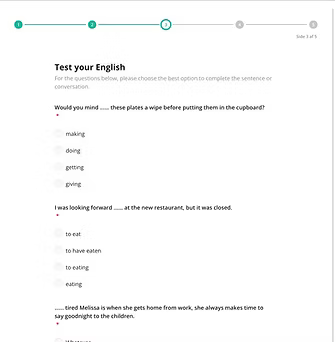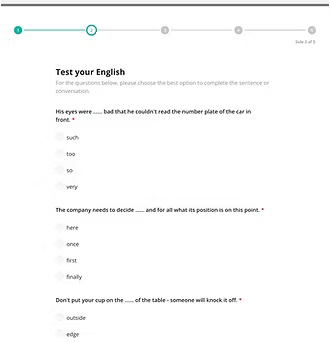Why the spoken language has become a crucial factor
A vast majority of software platforms supports writing and reading covering almost every language. This raises the importance to ensure the surrounding world of your actual capabilities within the spoken language and how well you can make yourself understood in both professional and in social surroundings.
Simplifying the process by using your phone as a microphone
When performing a spoken language test, the speaking exercise itself is converted into text. From thereon the text is examined and measured to calculate the current level of proficiency.
The five main measures are as follows:
> Lexical Diversity
> Vocabulary Richness
> Flech-Kincaid
> Sentence length
> Correctness of grammar

Your Spoken Capabilities
When assessing language skills, it’s essential to show how clearly you can interact and make yourself understood in conversations.
This is especially valuable when applying for jobs or participating in situations where spoken communication matters - such as joining meetings, presenting your work, or collaborating with others in general.
5 major languages
(English, French, Spanish, Portuguese, German)
We at Prolistique evaluates your speaking ability in five different languages, enabling you to test and showcase your proficiency in the specific language you need.
Measures
During a spoken language assessment, the test taker’s speech sample is automatically transcribed into text. The resulting transcript undergoes linguistic analysis (non AI) to determine the candidate’s proficiency level based on a defined set of quantitative linguistic indicators alongside a validation on length word counts to live up to the minimum requirements of test to be analyzed.
The five core analytical measures are:
Lexical Diversity – the range of unique vocabulary items used within the sample.
Vocabulary Richness – the sophistication and contextual appropriateness of lexical choice.
Flesch–Kincaid Readability Index – a quantitative measure of textual complexity derived from word and sentence structure.
Sentence Length – an indicator of syntactic complexity and grammatical range.
Grammatical Accuracy – the frequency and severity of grammatical deviations relative to standard usage norms.
Each metric is assigned a weighted coefficient within the scoring model to normalise variance across analytical dimensions. This weighting ensures that disproportionate performance in any single area does not unduly influence the composite proficiency score. The aggregated outcome provides a balanced, statistically robust estimation of the candidate’s overall language competence.
Lexical Diversity
In language level testing, measuring lexical diversity provides valuable insight into a candidate’s breadth of vocabulary knowledge and their ability to select appropriate words in context.
Vocabulary richness
This measure refers not only to how many different words a person uses (lexical diversity) but also to how sophisticated, precise, and contextually appropriate those words are. It captures both the range and the quality of vocabulary.
Flesch–Kincaid
The Flesch–Kincaid readability formulas (Reading Ease and Grade Level) measure how difficult a text is to understand based on sentence length and word complexity (typically syllable count). This ensures comparable linguistic complexity and to avoid accidental bias due to overly complex phrasing. Flesch–Kincaid is not used to score the test-taker, but to validate the test content. It helps developers maintain balanced difficulty, fairness, and adaptive precision — key qualities of any scientifically sound language level assessment.
Sentence length
This measured the average number of words per sentence as a reliable indicator of both syntactic complexity and processing difficulty in a language assessment context. Longer sentences often indicate that the test taker can use subordination, connectors, and complex structures (e.g., relative clauses, conditionals, participle phrases).
Grammatical Accuracy and CEFR Alignment
Grammar checking provides an objective, data-driven measure of syntactic and morphological control. By aligning error-based metrics with CEFR descriptors and validated human benchmarks, the system delivers a reliable, scalable, and transparent measure of grammatical proficiency within the broader construct of communicative competence. The grammar score is integrated into the composite proficiency model alongside lexical and structural indicators. Its weighting typically reflects its relative importance to overall communicative competence. This ensures that candidates are rewarded not only for vocabulary and fluency but also for the accuracy and stability of their grammatical control — a defining feature of CEFR progression.
Methodological Note
The weighting coefficients for each metric are derived through regression analysis and empirical calibration against benchmark datasets aligned with Common European Framework of Reference (CEFR) proficiency levels. Each linguistic variable is tested for predictive validity, inter-measure correlation, and stability across sample populations. The final model employs normalised z-scores to harmonise scales and mitigate outlier effects, ensuring that the composite index reflects a holistic, evidence-based measurement of communicative proficiency rather than an overemphasis on any single linguistic dimension.
Cambridge Placement Test
Over the years, the language department at the University of Cambridge has continually refined its methodology, evolving from traditional paper-based tests to a fully online, adaptive testing platform. This adaptive approach adjusts the difficulty of each question based on your responses, ensuring that the assessment accurately reflects your true level of English proficiency.
This test is valuable if you are considering enrolling in further language training courses or other relations to your educational or employment situation having to demonstrate your capabilities further.
Adding Cambridge Placement Test to your overall linguistic test, gives you or your employer the ability to measure where to focus any extra training or direct courses, to improve your language skills in English. The Cambridge placement test is only valid in the English Language.
>> Download example test report

Enroll for your Language Level Certificate
Select the certificate type matching your purpose and complete the form to get started
Spoken Test Certificate | VPI
€ 65,00 inkl. moms
- Mundtlig test (VPI score)
- Lydoptagelse af din test
- 12-24 timers behandlingstid
English Level Certificate + Cambridge Test
€ 85,00 inkl. moms
- Mundtlig test (VPI score)
- Cambridge Assessment English test
- CEFR-certificering
- Fuld sprogvurdering
Vælg en certifikattype ovenfor for at fortsætte med tilmeldingen


